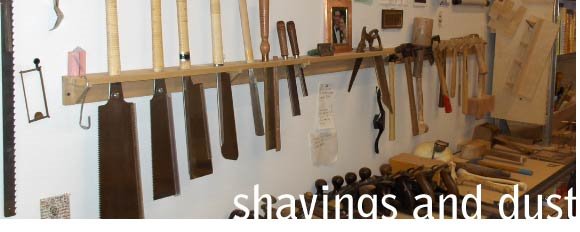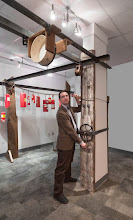 There is a concept in Japan that is called ma. The ideogram is shown to the left there, and though I am not a Japanese scholar I have it on good authority that what we are looking at is the ideogram for "gate" or "door" (the two parts to the left and right) and the ideogram for "sun" (the square in the middle). So the ideogram shows light shining through a space between objects, which is exactly what ma is: a gap, an opening, a space between two things, a silence.
There is a concept in Japan that is called ma. The ideogram is shown to the left there, and though I am not a Japanese scholar I have it on good authority that what we are looking at is the ideogram for "gate" or "door" (the two parts to the left and right) and the ideogram for "sun" (the square in the middle). So the ideogram shows light shining through a space between objects, which is exactly what ma is: a gap, an opening, a space between two things, a silence.Ma, I am learning, is one of those concepts that does not easily translate cleanly into English, but it is a beautiful idea, and one that as a designer and maker I am falling in love with. It is what the quote by a famous musician (which I always heard attributed to Miles Davis, but the internet variously attributes to Claude BeDussey, W A Mozart, and a Zen koan) means when it talks about music being "the silence between the notes." That is ma.
I am intrigued by the idea that beauty might not just come from an object, it might come from the space between objects. That is, that emphasis is taken off of the object itself and transferred to a non-object, a space, energising it to the point that the space becomes object-like, if you take my meaning. This does not diminish the import of the objects on either side, in fact it increases their importance, because the ma that is created depends heavily on what it lies between.
Robert Edmond Jones, father of American set design and still a hero though I am no longer involved with the performing arts, wrote that "A chair is just a chair. It is in the arrangement of the chairs that the magic lies." He was getting at this same idea, I think, this idea that everything is contextual. A chair can be perfect or terrible depending on the context we find it in, and empty space can be useless or beautiful depending on what lies on either side of it.
So ma.
 We have been visiting a lot of gardens, and it is in these miniature worlds that the Japanese are so fond of creating that I am coming to be a real lover of the idea of ma. The tension of a branch hanging over the water is something that I had noticed before as being beautiful, but had not known was a concept in itself, a specific way of creating beauty in a thoughtful and considered manner. Now that I am paying attention to it, of course, I am seeing everywhere (like when you have your first kid and suddenly you see babies everywhere), often in gardens but then also in other places as well.
We have been visiting a lot of gardens, and it is in these miniature worlds that the Japanese are so fond of creating that I am coming to be a real lover of the idea of ma. The tension of a branch hanging over the water is something that I had noticed before as being beautiful, but had not known was a concept in itself, a specific way of creating beauty in a thoughtful and considered manner. Now that I am paying attention to it, of course, I am seeing everywhere (like when you have your first kid and suddenly you see babies everywhere), often in gardens but then also in other places as well. This is in the gardens of the Imperial Villa at Katsura. Here I see the ma in the space between the bridge and the reflection of the bridge. The space of the ma is made more beautiful because it is part real and part illusion, part real-world and part reflected world. This made me stop and stare for so long the person behind me on the tour walked around me.
This is in the gardens of the Imperial Villa at Katsura. Here I see the ma in the space between the bridge and the reflection of the bridge. The space of the ma is made more beautiful because it is part real and part illusion, part real-world and part reflected world. This made me stop and stare for so long the person behind me on the tour walked around me.Another shot from the Katsura Villa. This also falls into the "propped up tree" category, which I promise I am going to write about soon. Holy cow, the propped up trees are amazing here. But here it is the tension of the tree leaning out over the water that I find so captivating. Knowing how heavy that tree is, and knowing what forces are keeping it there really energise how the space between the water and the tree trunk. There is a beauty that is created there that is so much greater than if the tree were growing out of the water or were standing straight on the island.
All of these gardens are so carefully designed that I forget sometimes how specifically they have been orchestrated. Not that there is any pretense that they are natural growth, rather that as a teacher said to me once "the best design is the design that is so right and so well-thought out that you are not immediately aware of it at all." That is what is happening in these gardens: I am not immediately aware that they have been designed, because the sense of beauty and attention to detail is so pleasing that I forget momentarily to be aware of them as designed spaces.
 Here is the fountain at Kiyomizu-deru, I think I posted this one already. The water could have been left to fall naturally down the rocks, but by being routed through the three troughs and let to fall into the basin below we become acutely aware of not just the trough and the basin but also the space, the air, the distance that the water falls and the form it takes as it does so and the sound it makes as it lands. That air is so important to the whole experience, the beauty encoded in it is what is central to this waterfall, almost more than the water itself.
Here is the fountain at Kiyomizu-deru, I think I posted this one already. The water could have been left to fall naturally down the rocks, but by being routed through the three troughs and let to fall into the basin below we become acutely aware of not just the trough and the basin but also the space, the air, the distance that the water falls and the form it takes as it does so and the sound it makes as it lands. That air is so important to the whole experience, the beauty encoded in it is what is central to this waterfall, almost more than the water itself.
Okay, last one and then I am done. This is the beam that I posted the other day, also from Kiyomizu-dera. Looking at it as an object about ma, the space in the joint becomes so much more evocative. When I posted this photo before it was about the joint and about the history of it and of the temple and of the person who made it, but looking at it in this light, the hole (called a mortice) becomes beautiful in its own right, evocative and sad and lovely. Beautiful and eloquent in its emptiness.
And of course this gets me to thinking about the space between people, and about how that can be appreciated and used thoughtfully and even celebrated. This idea that objects or people have identities but that the relationship between those identities and the new identity that is created when the whole package is considered has a relevance when I think about the community-building work that I have been doing. It is helpful to me to think about in those terms.
So much good stuff here.



3 comments:
You just brought two images rushing back to my mind. In both, I couldn't even see the actual image for a long time, I could only see the negative space and the pictures it made. One was the old Superman logo, which I thought was a couple of yellow fish swimming on a field of red. And the other was a cross stitch of the word "Jesus" in my grandmother's kitchen, in block letters. The letters were red and the field was white, but I could only see the boxy shapes in the white. People never understood me when I asked about these images, but I think seeing things differently like this has become a big part of who I am today. I really appreciate the post and the memories you brought back!
You just brought two images rushing back to my mind. In both, I couldn't even see the actual image for a long time, I could only see the negative space and the pictures it made. One was the old Superman logo, which I thought was a couple of yellow fish swimming on a field of red. And the other was a cross stitch of the word "Jesus" in my grandmother's kitchen, in block letters. The letters were red and the field was white, but I could only see the boxy shapes in the white. People never understood me when I asked about these images, but I think seeing things differently like this has become a big part of who I am today. I really appreciate the post and the memories you brought back!
Love this, Janine. And yes. That is the thing I think I am trying to get at, that we are so trained to look at the thing that we forget that there are other ways of seeing. I like the yellow fish thing. That is awesome.
Post a Comment